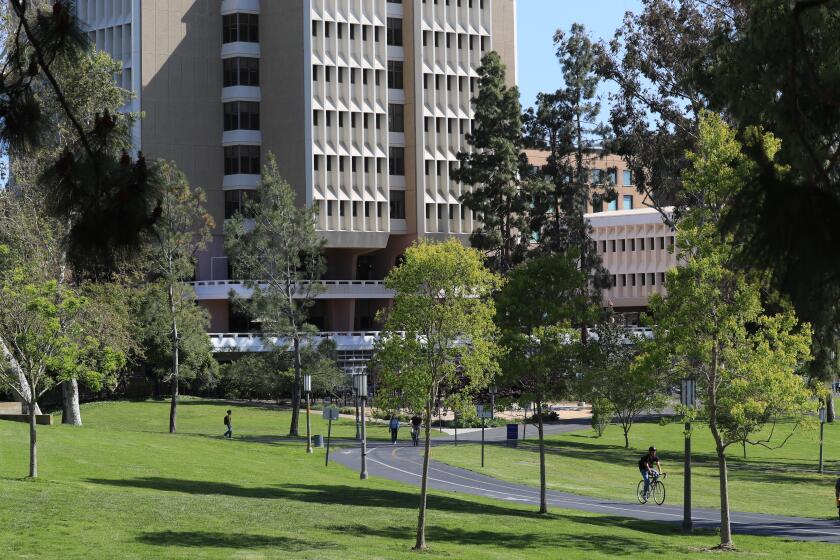Libya artists relish newfound freedom
- Share via
Reporting from Benghazi, Libya — The leering visage of Moammar Kadafi, surrounded by rats made of plaster, stares down at visitors to a new art exhibit on the Benghazi waterfront.
The Kadafi caricature stands 12 feet tall. It depicts the Libyan leader as a derelict imprisoned in a 15-foot-high trash bin and deluged with garbage.
Titled “Dustbin of History,” the work is the centerpiece of a new art exhibit sanctioned by the rebel movement fighting to overthrow Kadafi after 41 years of suffocating rule.
“Kadafi is heading to the trash bin soon, God willing,” said the artwork’s creator, a long-haired, woolly-bearded former underground artist named Ali Wakwak.
Part art and part agitprop, the “Crimes of Kadafi” exhibit encapsulates the contempt and dread Libyans in the rebel-controlled east hold for the besieged strongman in Tripoli. Unveiled July 18, the show also reflects the burgeoning spirit of liberation and openness that has engulfed Benghazi since an uprising drove Kadafi’s security forces from eastern Libya in mid-February.
Under Kadafi, art was strictly regulated. Any work that hinted of political commentary was ruthlessly repressed. Kadafi favored kitschy artistic tributes to his people’s socialist republic and his iconic role as “Brother Leader.”
Kadafi “had no use for art; he considered it subversive,” said Mohammed Tarhouni, 53, co-creator of the rubbish bin piece.
Rebel leaders have housed the exhibit in a historically significant building: the Italianate villa where the late King Idris announced independence for Libya in 1951. Fresh red paint proclaims it the new home of the Kadafi Crimes Museum.
Kadafi, who overthrew Idris in 1969, later confiscated the building, converting it from an art university to offices for regime functionaries. The bottom floor, burned by revolutionaries in February, has been left charred as a tribute to the rebellion.
The smoke-damaged space is now dedicated to artworks condemning Kadafi’s jailing and execution of dissidents, and the shooting of street protesters by his security police during the eastern revolution.
One artwork features crumpled Grad missile nose cones and is titled, in English (the exhibit courts an international audience), “Terrorism and Grad Missiles.” Another work, “The Tyrant’s Crimes,” is composed of expended ammunition casings.
Outside, scraps of fighter plane wreckage are displayed beside photos of Libyan air force pilots who defected to the rebels and fired on government forces besieging Benghazi in March before being shot down and killed.
An entire gallery is devoted to Kadafi caricatures that depict him as a butcher dripping with blood, a wild-eyed mass murderer, or a terrorist lighting a fuse that leads to oil barrels stacked atop Libya.
One work portrays Kadafi as a prison inmate and is titled “Soon.”
Another gallery displays drawings by schoolchildren clearly inculcated by their elders with the concept of Kadafi as a venal tyrant. Their drawings show Kadafi clutching bags of money or admiring piles of his victims’ skulls.
Upstairs, the walls are lined with hundreds of snapshots of Libyan men who the rebels say were executed, jailed or shot by Kadafi security forces.
One exhibit features scores of photos and captions, each one titled “Information Card of a Martyr.” There are photos and biographical sketches of men said to have been killed by government security forces in street protests or in battle.
Some of the art is for sale, but only a few foreign aid workers or journalists have made purchases.
“Libyans are too busy trying to find food or fuel to buy art,” said Abdelgader Badr, 47, an oil company chemical engineer and amateur artist whose abstract works are on display.
The exhibit is popular among rootless young men in jeans and sport shirts who split their time between the front and coffee cafes in Benghazi. But young women in white head scarfs and black T-shirts emblazoned with the rebel flag also roam the galleries, giggling and posing for cellphone snapshots.
Schoolchildren in tour groups race through the exhibits, pointing and gaping at Kadafi caricatures. Families study the pieces, with fathers struggling to explain the artworks’ message.
“Any Libyan seeing this art is the luckiest person on Earth,” Wakwak said. “We artists have been waiting 41 years to have our art displayed in public instead of hiding it in our homes.”
The most popular piece is “Dustbin of History,” positioned at the entrance to the building. Wakwak said he was inspired by a comment from a well-known commentator on government-run TV who said the rebels would end up in the dustbin of history, a phrase first attributed to the Bolshevik Leon Trotsky.
Wakwak, 63, looks like an aging hippie. He wore a rumpled shirt and dirty jeans. His gray hair was knotted in a tangled ponytail beneath a rebel flag hat emblazoned with the words “New York.” After earning an art degree in Beirut, he said, he secretly crafted art pieces at home in Benghazi, displaying them and selling them to friends.
It took Wakwak and Tarhouni about three weeks to create the rubbish bin piece using scrap wood and metal, plaster and burlap. The huge trash bin was made from metal fencing.
The concept came to him easily, Wakwak said.
“Kadafi called us rats, so we put rats on his shoulders,” Wakwak said. “He called us garbage, so we made sure that everyone sees him covered with garbage. We wanted to humiliate him.”
More to Read
Sign up for Essential California
The most important California stories and recommendations in your inbox every morning.
You may occasionally receive promotional content from the Los Angeles Times.











